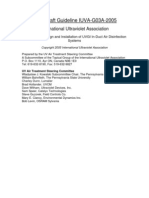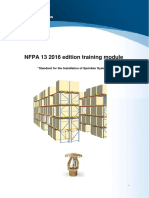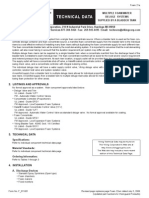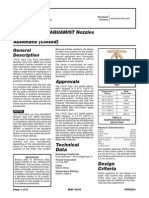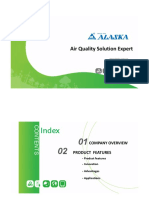NFPA 33 Presentation
NFPA 33 Presentation
Uploaded by
marciojunkCopyright:
Available Formats
NFPA 33 Presentation
NFPA 33 Presentation
Uploaded by
marciojunkCopyright
Available Formats
Share this document
Did you find this document useful?
Is this content inappropriate?
Copyright:
Available Formats
NFPA 33 Presentation
NFPA 33 Presentation
Uploaded by
marciojunkCopyright:
Available Formats
!
nlA 33
SLandard for Spray Appllcauon uslng
llammable or Combusuble MaLerlals
llre revenuon Cmcers' Assoclauon
of 8rlush Columbla 2013 Annual
Semlnar
kelowna, 8rlush Columbla
May 9, 2013
NFPA 33 Scope
Applies to the spray application of
flammable or combustible materials by:
! Compressed air atomization
! Airless or hydraulic
atomization
! Electrostatic application
! Other atomized application
methods
Scope
This standard also applies to the application of
flammable or combustible materials applied by:
! Fluidized bed application methods.
! Electrostatic fluidized bed application methods.
! Other means of fluidized application.
! Automated Electrostatic Spray Equipment.
! Handheld Electrostatic Spray Equipment.
! Drying, Curing and Fusion Processes.
! Organic Peroxides and Plural Component
Coatings.
! Styrene Cross-Linked Composites
Manufacturing (Glass Fiber-Reinforced
Plastics)
Scope
Also applies to spray application of water-borne, water-based,
and water-reducible materials that:
! Contain flammable or combustible liquids.
! Produce combustible deposits or resin.
Scope
This standard does not apply to:
! Spray applications performed outdoors.
! Portable spraying equipment.
! Aerosol products up to 1 Liter.
! Application of noncombustible
materials.
! Address toxicity or industrial health and
hygiene.
Does NFPA 33 Apply?
Definitions
! Flash-Off Area- An open or enclosed area after a spray
application process where vapors are released due to
exposure to ambient air or a heated atmosphere.
! Spray Area- Any area in which dangerous quantities of
flammable or combustible vapors, mists, residues, dusts or
deposits are present due to the operation of spray processes
(any area in the direct path of a spray application process,
the interior of a spray booth or spray room, the interiors of
the exhaust plenum, eliminator/scrubber section, exhaust
duct or stack).
Definitions
! Fluidized Bed- A chamber holding powder coating material that is
aerated from below to form an air-supported, expanded cloud of
the powder.
! Electrostatic Fluidized Bed- Similar to above but the powder is
electrically charged with a charge opposite to that of the object
being coated.
! Nonincendive- Electrical equipment and associated wiring that are
incapable, under normal operating conditions, of releasing
sufficient electrical or thermal energy to cause ignition of specific
hazardous materials in their most easily ignited concentrations in
air.
Definitions
! Overspray- Any sprayed material that is not deposited on
the intended object.
! Spray Booth- A power-ventilated enclosure for a spray
application operation or process that confines and limits the
escape of the material being sprayed, including vapors,
mists, dusts and residues and conducts or directs these
materials to an exhaust system. The booths can be of the
Dry, or Water-Wash type.
Definitions
! Spray Room- A power ventilated fully enclosed room used
exclusively for open spraying of flammable or combustible
materials.
! Ventilation- Movement of air that is provided for the
prevention of fire and explosion and is sufficient to prevent
accumulation of vapor-air mixtures in concentrations over
25% of the lower flammable limit.
Location
! Spray application operations and processes shall be confined
to spray booths, spray rooms, or spray areas.
! Spray application operations and processes shall not be
conducted in any A, E, I or R occupancy unless they are
located in a room that is separated by 2 hour fire rated
construction and protected by an approved automatic fire
sprinkler system.
Design and Construction
! Walls and ceilings shall be constructed of noncombustible
or limited combustible materials with interior surfaces
smooth (cannot trap residue or restrict ventilation or
cleaning).
! Aluminum shall not be used unless it is limited to ancillary
devices.
Design and Construction
! Spray Rooms shall be constructed of
and separated from surrounding areas
of the building by 1 hour fire rated
construction.
! Enclosed spray booths/rooms shall be
provided with means of egress that meet
the requirements of NFPA 101.
! Conveyor openings that are necessary
for transporting or moving work into
and out of the spray area shall be as
small as practical.
Design and Construction
! Spray booths shall be separated from other operations by a
minimum distance of 915mm or by a partition, wall, or
floor/ceiling assembly with a minimum 1 hour fire
resistance rating.
! All parts must be readily accessible for cleaning.
! A clear space of not less than 915mm shall be maintained
on all sides and above (Exceptions for walls).
Design and Construction
! Panels for light fixtures or
observation shall be of heat-treated
glass, laminated glass, wired glass,
or hammered wired glass and shall
be sealed to confine vapors, mists,
residues, dusts and deposits to the
spray area.
! Panels for the light fixtures shall be
separated from the fixture to
prevent the surface temperature of
the panel from exceeding 93c
Design and Construction
Spray areas that are equipped with ventilation distribution or baffle plates or with
dry overspray collection filters shall:
! Have distribution plates or baffles constructed of noncombustible materials
and be readily accessible for cleaning.
! Not use filters when applying materials known to be highly susceptible to
spontaneous heating/ignition.
! Have filter supports constructed of noncombustible materials.
! Have filters readily accessible for cleaning or replacement.
! Not allow filters to be alternately used for different types of coating materials.
Electrical Area Classification
(Abbreviated)
Class I- Any location where flammable gas or vapor is present or
might be present in the air in quantities sufficient to produce an
explosive or ignitible mixture.
! Class I, Division 1- Above condition exists in normal operating
conditions. Condition can exist frequently due to repair or
maintenance operations, or leakage. Breakdown or faulty
operation of equipment can release ignitible concentration with
potential simultaneous failure of electrical equipment in such a
way that it becomes a source of ignition.
Electrical Area Classification
(Abbreviated)
! Class I, Division 2- Similar conditions to previous slide but
the flammable gas, vapor or liquid is confined within a
closed container or system and only escapes in cases of
accidental rupture or breakdown of the container/system or
abnormal operation of equipment. Ignitible concentration
is prevented by positive mechanical ventilation (unless
failure). An ignitible concentration may be transmitted from
a CI, D1 location if failure of positive mechanical
ventilation.
Electrical Area Classification
(Abbreviated)
Class I, Zone 0- Location where an ignitible concentration of
flammable gas or vapor is continuously present
Class I, Zone 1- Location where one of the following conditions
exist.
! Ignitible concentration of flammable gas or vapor exists under
normal conditions, during repair/maintenance. Breakdown may
cause ignitible concentration and simultaneous failure of electrical
system that could be an ignition source. Ignitible concentration
may be transmitted from a CI, Z1 location.
Electrical Area Classification
(Abbreviated)
Class I, Zone 2- Location where one of the conditions exist
! Ignitible concentration of flammable gas or vapor is not
likely to exist under normal operating conditions, or exists
for only a short period of time. Flammable gas or volatile
flammable liquid is present but is confined within a closed
container. Ignitible concentration is prevented by positive
mechanical ventilation. Ignitible concentration may be
transmitted from a CI, Z1 location.
Electrical Area Classifications
(Abbreviated)
Class II- Locations similar to Class I but containing combustible dust.
(Also includes dust interfering with dissipation of heat.)
Zone 20- Locations where an ignitible concentration of combustible
dust is present continuously or for long periods of time.
Zone 21- Similar to Class I, Zone 1 locations but refers to dust.
Zone 22- Similar to Class I, Zone 2 locations but refers to dust.
Electrical Devices
! Spray area shall be Class I,
Division 1; Class I, Zone 1;
Class II, Division 1; or Zone
21 (whichever is applicable).
! Electrical equipment and
wiring located in the spray
area (and not subject to
combustible residues) shall
conform to above
classifications (whichever is
applicable).
Electrical Devices
Equipment and wiring
located outside but within
6100mm horizontally and
3050mm vertically of an
unenclosed spray area shall be
designated as shown in Figure
6.5.1
Electrical Devices
If spray application
operations are conducted
within a closed-top, open-face
or open-front booth, or room,
any electrical wiring or
equipment located outside the
booth/room but within
915mm of any opening shall
be designated as shown in
Figure 6.5.2
Electrical Devices
If spray application
operations are confined to an
enclosed spray booth or
room, the electrical area
classification shall be as
shown in Figure 6.5.4
Misc. Electrical
Open containers with
Class I liquids shall be
located with the electrical
area classifications shown
in Figure 6.5.5.2
Misc. Electrical
! Light fixtures outside the spray
area shall be listed for use
according to the area they
occupy.
! All electrically conductive
objects in the spray area shall be
electrically connected to
ground.
! Portable electric light fixtures
shall not be used in any spray
area while spray application
operations are being conducted.
Ventilation
Ventilating and exhaust systems
shall be designed and installed in
accordance with the applicable
requirements of NFPA 91, Standard
for Exhaust Systems for Air Conveying
of Vapors, Gases, Mists, and
Noncombustible Particulate Solids.
Ventilation
Each spray area shall be provided with mechanical ventilation that is
capable of:
! Confining and removing vapors and mists to a safe location.
! Confining and controlling combustible residues, dusts and
deposits.
! Concentration of vapors and mists in the exhaust stream of the
ventilation system shall not exceed 25% of the lower flammable
limit.
Ventilation
! Mechanical ventilation shall
be kept in operation at all
times while spray operations
are being conducted, and for a
sufficient time thereafter to
allow vapors from drying
coated objects.
! An adequate supply of clean
make-up air shall be provided
to compensate for the air
exhausted from spray
operations (shall not
recirculate exhaust air).
Ventilation
Air exhausted to the atmosphere from liquid spray operations shall be
conducted by ducts directly to the outside of the building, and:
! Shall follow the most direct route to the point of discharge.
! Shall be directed away from any fresh air intakes.
! The discharge point shall be at least 1830mm from any exterior
wall or roof.
! Shall not discharge in the direction of any combustible
construction within 7625mm of the discharge point (or any
unprotected opening).
Misc. Ventilation
! Use caution when allowing recirculation of exhausted air.
! Exhaust ducts shall not be manifolded together.
! Exhaust plenums and ducts shall be constructed of steel
(smooth concrete allowed).
! Exhaust ducts shall be supported to prevent collapse under
fire conditions (The weight of residue and fire sprinkler
discharge must be taken into account).
! All exhaust ducts shall be provided with doors, panels, or
other means to facilitate inspection and maintenance.
Storage and Handling
Storage, handling, and mixing of flammable and combustible
liquids shall meet all the applicable requirements of NFPA 30,
Flammable and Combustible Liquids Code
Storage and Handling
! The volume of Class I, II, III,
IIIA liquids in a storage
cabinet shall not exceed 454L.
! The total aggregate volume of
the above listed liquids in a
group of storage cabinets shall
not exceed the maximum
allowable quantity of
flammable and combustible
liquids per control area.
Storage and Handling
Industrial Occupancies shall not exceed the
MAQ per control area.
The quantity of liquid located in in the vicinity
of spraying operations but outside of identified
storage areas shall not exceed either
! The amount required to supply spraying
operations for one continuous 24-hour
period, or
! The aggregate sum of 95L of (Class IA), or
454L of (ClassIB, IC, Class II, Class III), or
6000L of (Class IB, IC, II or IIIA liquids in
portable metal containers), or 3000L of
(Class II or Class IIIA in nonmetalic bulk
containers) or Twenty portable tanks each
not exceeding 3000L of Class IIIB liquids.
Mixing
Mixing rooms shall meet all of the following requirements:
! Shall meet the construction requirements of Section 5.1
! The area shall not exceed 14m squared.
! Shall be designed to contain a spill of the contents of the room.
! Shall be provided with continuous mechanical ventilation and shall be in
operation at all times.
! Shall have an electrical classification the same as an enclosed spray booth.
! Shall be provided with an approved automatic fire protection system.
! Shall be provided with portable fire extinguishers in accordance with NFPA
10
Mixing
! The amount of liquid permitted in a
single spray area shall not exceed 227L
! Where a separate mixing room is
provided and is located within 1830mm
of an adjacent spray area, the combined
quantities of liquids shall not exceed
454L.
! Where a separate mixing room is
provided and is located more than
1830mm from an adjacent spray area,
the quantity of liquid permitted in the
mixing room shall not exceed 80L/m
squared (maximum 1135L), spray area
shall not exceed 227L.
Protection
Spray areas, which include by definition any associated
exhaust plenums and exhaust ductwork, any particulate filters,
any solvent concentrator units, any recirculation air supply
units, and mixing rooms, shall be protected with an approved
automatic fire protection system.
Protection
The automatic fire protection system shall be permitted to be, and
shall be installed in accordance with, any of the following:
! An automatic water sprinkler system (NFPA 13).
! An automatic foam water sprinkler system (NFPA 16).
! A carbon dioxide extinguishing system (NFPA 12).
! A dry chemical extinguishing system (NFPA 17)
! A gaseous agent extinguishing system (NFPA 2001)
Protection
For continuous spray application operations,
activation of the automatic fire protection
system shall automatically accomplish all of
the following:
! Activate a local alarm in the vicinity of
the spraying operation.
! Transmit an alarm signal to the facilitys
fire alarm system.
! Shut down the coating material delivery
system.
! Shut down all spray application
operations.
! Stop any conveyors into and out of the
spray area.
Protection
Automatic Sprinkler Systems shall
take the following into
consideration:
! Shall be a wet pipe, dry pipe,
preaction, or open-head deluge
system (whichever is most
appropriate).
! Shall be designed for Extra
Hazard (Group 2) occupancies.
! Water supply shall be sufficient
to supply all sprinklers likely to
open without depleting the
available water for hose streams.
Protection
! System shall be controlled by a separate listed indicating valve,
operable at floor level.
! Stacks and exhaust ducts shall be provided with access openings
for inspection and cleaning of sprinklers.
! Sprinklers shall be protected against overspray residue, either by
location or covering (only by cellophane bags having a thickness
of .08mm or less or by thin paper bags).
! Sprinklers that have been painted or coated by overspray shall be
replaced with new sprinklers.
Protection
! Automatic Carbon Dioxide,
Dry Chemical, and Clean
Agent Systems shall be
capable of discharging its
contents into the entire
protected area simultaneously,
including the exhaust plenum
and exhaust ductwork.
! Portable fire extinguishers
shall be provided and located
in accordance with NFPA 10,
Standard for Portable Fire
Extinguishers.
Protection
Automated powder application equipment, and Automated
liquid electrostatic spray application equipment, both listed
and unlisted, shall be further protected by listed optical flame
detection, installed and supervised in accordance with NFPA
72, National Fire Alarm and Signaling Code. This action shall
stop all processes and conveyors, shut down ventilation and
electrical equipment, and activate the automatic protection
system.
Operations and Maintenance
Maintenance procedures shall be established to ensure that all
spray application apparatus and processes are operated and
maintained in accordance with the manufacturers
specifications and the requirements of this standard.
Maintenance shall be the responsibility of the users of the
apparatus and processes.
Operations and Maintenance
! All spray areas shall be kept free of excessive accumulation
of deposits of combustible residues.
! If residue accumulates to excess in booths, ducts, or duct
discharge points, or other spray areas, all spraying
operations shall be discontinued until conditions have been
corrected.
Operations and Maintenance
! Maintenance procedures shall be established to ensure that
overspray collector filters are replaced before excessive
restriction to airflow occurs.
! At the close of the days operation, all discarded overspray
collection filters, residue scrapings, and debris contaminated
with residue shall be removed and placed in a
noncombustible container with a tight fitting lid in a
designated storage location.
Operations and Maintenance
! Approved waste containers
shall be provided wherever
rags or waste are impregnated
with sprayed material, and all
such rags or waste shall be
deposited therein immediately
after use.
! Employee clothing
contaminated with sprayed
material shall not be left on
the premises overnight unless
kept in a metal locker.
Training
All personnel involved in the spray
application processes covered by this
standard shall be instructed in the
following:
! Potential safety and health
hazards.
! Operational, maintenance, and
emergency procedures required.
! Importance of constant operator
awareness.
Training
! Personnel required to handle or use flammable or
combustible materials shall be instructed in the safe
handling, storage, and use of the materials, as well as
emergency procedures.
! All personnel required to enter or to work within confined
or enclosed spaces shall be instructed as to the nature of the
hazard involved, the necessary precautions to be taken, and
the use of protective and emergency equipment required.
Training
All personnel shall be instructed
in the proper use, maintenance,
and storage of all emergency,
safety, or personal protective
equipment that they might be
required to use in their normal
work performance.
Documentation shall be
employed to record the type and
date of the training provided to
each individual involved in these
processes.
Cuesuons?
Cary !. Ponold, C.l..S.
8eglonal ulrecLor, norLhwesL lleld Cmce
2814 8rooks SL. SulLe 240
Mlssoula, MonLana 39803
406-241-3981
ghonold[nfpa.org
Thank You!
You might also like
- NFPA 101 Handbook 2018 36Document1 pageNFPA 101 Handbook 2018 36Sundar Rz0% (1)
- FSSA Guide To Estimating Pressure Relief Vent Area 2 EditionDocument1 pageFSSA Guide To Estimating Pressure Relief Vent Area 2 EditionLaura Galarza100% (1)
- Ul555 555S 702 PDFDocument2 pagesUl555 555S 702 PDFRiaz ahmed100% (3)
- NFPA 33 Paint Booth Check SheetDocument19 pagesNFPA 33 Paint Booth Check Sheetaravindappi100% (1)
- FHC User ManualDocument43 pagesFHC User ManualJosé Carlos Mairena Zumbado0% (1)
- FM Global Loss Prevention Data Sheet 3 26 Fire Protection Fo Non Storage Sprinklered PropertiesDocument13 pagesFM Global Loss Prevention Data Sheet 3 26 Fire Protection Fo Non Storage Sprinklered PropertiesDaniel Aloysio Rojas Martins67% (3)
- Dokumen - Tips Novec 1230 System Design 3m Novec 1230 Fire Protection FluidDocument73 pagesDokumen - Tips Novec 1230 System Design 3m Novec 1230 Fire Protection FluidMithilesh GuruNo ratings yet
- Inspection Guide For Fire Inspection & AuditsDocument37 pagesInspection Guide For Fire Inspection & Auditssai kiran100% (1)
- NFPA 80A - 2001-Rop PDFDocument11 pagesNFPA 80A - 2001-Rop PDFNidas Sameera50% (2)
- Sample Project For Nfpa 80A Application To Building Exposure ScenarioDocument12 pagesSample Project For Nfpa 80A Application To Building Exposure ScenarioBrij MishraNo ratings yet
- General Brochure AVAPACDocument37 pagesGeneral Brochure AVAPACmarciojunkNo ratings yet
- IUVAG03A 2005HiLiteDocument22 pagesIUVAG03A 2005HiLiteWemhoffpNo ratings yet
- 1.1. OSTEOPro DEXA User's Manual - V3.0 - 20120202Document94 pages1.1. OSTEOPro DEXA User's Manual - V3.0 - 20120202Sergio Alejandro Castro100% (1)
- IMO Resolution 1050 - Entry Into Enclosed Spaces PDFDocument14 pagesIMO Resolution 1050 - Entry Into Enclosed Spaces PDFpgupta71100% (1)
- Building EnvelopeDocument47 pagesBuilding EnvelopeGretel Adrianne Umali67% (3)
- FM Global Property Loss Prevention Data Sheets: Ignitable Liquid OperationsDocument60 pagesFM Global Property Loss Prevention Data Sheets: Ignitable Liquid OperationsElbechir SenkezNo ratings yet
- Sapphire Manual PN570590Document101 pagesSapphire Manual PN570590FitflowPeruNo ratings yet
- Fire Drencher System - Base-Engineer PDFDocument2 pagesFire Drencher System - Base-Engineer PDFpequenita34100% (1)
- UL 762 Power Ventilators For Restaurant Exhaust AppliancesDocument1 pageUL 762 Power Ventilators For Restaurant Exhaust AppliancesProyectos 2 UezuNo ratings yet
- Tyco Water Curtain NozzleDocument2 pagesTyco Water Curtain NozzlejonejackrousseauNo ratings yet
- Approval Standard For Clean Agent Extinguishing Systems: Class Number 5600Document74 pagesApproval Standard For Clean Agent Extinguishing Systems: Class Number 5600ambition1340cn100% (1)
- NFPA 2001 Code Review (2018 Edition)Document5 pagesNFPA 2001 Code Review (2018 Edition)Swaraj Biswas0% (1)
- FMDS0326Document15 pagesFMDS0326Story LoveNo ratings yet
- Basic Training Workbook SettingsDocument8 pagesBasic Training Workbook SettingsIvonn OchoaNo ratings yet
- NFPA 13 2016 Edition Training Module: "Standard For The Installation of Sprinkler Systems"Document3 pagesNFPA 13 2016 Edition Training Module: "Standard For The Installation of Sprinkler Systems"Jorge InostrozaNo ratings yet
- Alternative Sprinkler Systems Design According To NFPA 13 PDFDocument25 pagesAlternative Sprinkler Systems Design According To NFPA 13 PDFethan8888No ratings yet
- Fm200 CalculatorDocument1 pageFm200 CalculatorFadyNo ratings yet
- Fire Sprinkler Valve - FM GlobalDocument16 pagesFire Sprinkler Valve - FM Globaldg dsNo ratings yet
- Multiple Foam Deluge SystemDocument10 pagesMultiple Foam Deluge SystemTrần VânNo ratings yet
- BW11 Fire Rated Duct 01 PDFDocument24 pagesBW11 Fire Rated Duct 01 PDFGhulam NurNo ratings yet
- FM Print Plant SafetyDocument26 pagesFM Print Plant SafetyEvert AlexNo ratings yet
- Topic 7 Fire Protection SystemDocument158 pagesTopic 7 Fire Protection SystemAlan Jade de LeonNo ratings yet
- Promat PFPH Chapter 1 Introduction PDFDocument16 pagesPromat PFPH Chapter 1 Introduction PDFHeba S. Al-saudiNo ratings yet
- Naffco Foam SystemDocument40 pagesNaffco Foam SystemMd. Asrafujjaman (Livon)No ratings yet
- Sprinkler Sloped - Ceilings - 2010 PDFDocument7 pagesSprinkler Sloped - Ceilings - 2010 PDFnrodinis7No ratings yet
- Pocket Guide To Inspection Testing and Maintaining Fire ProtectionDocument99 pagesPocket Guide To Inspection Testing and Maintaining Fire ProtectionBabak Hajizadeh100% (1)
- FHC - Sprinkler Hydraulic Calculation Software For The Fire Sprinkler IndustryDocument4 pagesFHC - Sprinkler Hydraulic Calculation Software For The Fire Sprinkler IndustryAisha Riaz100% (1)
- Calc InergenDocument12 pagesCalc InergenedenNo ratings yet
- FOGTEC Technical InformationDocument46 pagesFOGTEC Technical InformationFlorin GeorgeNo ratings yet
- Hydraulic Calculations For Small RoomsDocument4 pagesHydraulic Calculations For Small RoomsAnonymous qrSsYuxyoYNo ratings yet
- Close-Spacing and Restricted Air-Flow SituationsDocument14 pagesClose-Spacing and Restricted Air-Flow SituationsPablo ArosteguiNo ratings yet
- Sfpe Nfpa 13 Presentation PDFDocument40 pagesSfpe Nfpa 13 Presentation PDFاحمد الجزار2007No ratings yet
- Tyco - Ultra Low Flow Aquamist AM30Document2 pagesTyco - Ultra Low Flow Aquamist AM30cosmynns100% (1)
- NFPA 101 Essentials Training Module 1Document8 pagesNFPA 101 Essentials Training Module 1Alejo SztybelNo ratings yet
- Astm E84Document4 pagesAstm E84Hai TranNo ratings yet
- Fire Extinguisher Placement and Design ProcedureDocument16 pagesFire Extinguisher Placement and Design ProcedureDIEGOZaf100% (1)
- A Tutorial To Getting Started With FHC: Hydraulic Calculation Software For Water Based Fire Protection SystemsDocument7 pagesA Tutorial To Getting Started With FHC: Hydraulic Calculation Software For Water Based Fire Protection SystemsZaw Moe Khine100% (1)
- PRE - Eurocode Concerning To Fire - 0268Document62 pagesPRE - Eurocode Concerning To Fire - 0268nebojsadj6411No ratings yet
- Hose Stream Demands - Part 1Document4 pagesHose Stream Demands - Part 1Sergio Garro100% (1)
- NFPA 101 Handbook 2018 44Document1 pageNFPA 101 Handbook 2018 44sundarayya giscoNo ratings yet
- Light Hazard Design Criteria (Guide) : Check Highest Expected Ceiling TemperatureDocument13 pagesLight Hazard Design Criteria (Guide) : Check Highest Expected Ceiling Temperatureمحمد الامين100% (1)
- Passive Fire Protection Getting It Right Wilf Butcher PDFDocument44 pagesPassive Fire Protection Getting It Right Wilf Butcher PDFSonny Ramos100% (1)
- Fire Protection Calculations For Aircraft Hangar Group I 1644160228Document9 pagesFire Protection Calculations For Aircraft Hangar Group I 1644160228zubinsha08100% (1)
- Fire Audit - A Forward Looking ApproachDocument9 pagesFire Audit - A Forward Looking ApproachManish ChandaniNo ratings yet
- A Comparison of The Fire Suppression Performance o PDFDocument34 pagesA Comparison of The Fire Suppression Performance o PDFDayanne MartinsNo ratings yet
- Novec 1230 DesignDocument8 pagesNovec 1230 Designnandeesh100% (1)
- Sis & SilDocument65 pagesSis & SilGecNo ratings yet
- Hazardous Area Classification PONSL RevisedDocument106 pagesHazardous Area Classification PONSL RevisedMuhamad Firdaus Bin AzizanNo ratings yet
- Appendix 20 Electrical Installation Requirements: Hazardous Area ClassificationsDocument12 pagesAppendix 20 Electrical Installation Requirements: Hazardous Area ClassificationsNaveedNo ratings yet
- Ex Equipment GuideDocument4 pagesEx Equipment GuideRoadieNo ratings yet
- Sop Haz Area ClassDocument16 pagesSop Haz Area ClassBhushanNo ratings yet
- Hazardous Area Classification - JacobsDocument53 pagesHazardous Area Classification - Jacobskarthikraja21100% (1)
- Hazardous Location LightingDocument4 pagesHazardous Location LightingwahyuNo ratings yet
- Hazardous Area Classification - JacobsDocument53 pagesHazardous Area Classification - JacobsPedro Luis Choque Mamani100% (1)
- Hazardous AreasDocument29 pagesHazardous AreaspuneetNo ratings yet
- Calcium Citrate, Tetrahydrate MSDS: Section 1: Chemical Product and Company IdentificationDocument5 pagesCalcium Citrate, Tetrahydrate MSDS: Section 1: Chemical Product and Company IdentificationmarciojunkNo ratings yet
- CPT2012 C1(周) PDFDocument4 pagesCPT2012 C1(周) PDFmarciojunkNo ratings yet
- Isocure Catalyst 700Document8 pagesIsocure Catalyst 700marciojunkNo ratings yet
- Product Handling: Complete Solutions From A Single SourceDocument24 pagesProduct Handling: Complete Solutions From A Single Sourcemarciojunk100% (1)
- Resicoat R4-ES Fusion Bonded Epoxy: Product Data SheetDocument2 pagesResicoat R4-ES Fusion Bonded Epoxy: Product Data SheetmarciojunkNo ratings yet
- Fluid Bed Systems: P Ro / P Lu SDocument20 pagesFluid Bed Systems: P Ro / P Lu SmarciojunkNo ratings yet
- Grundfosliterature 4112587Document44 pagesGrundfosliterature 4112587marciojunkNo ratings yet
- Polytronxpex ManualDocument65 pagesPolytronxpex ManualmarciojunkNo ratings yet
- Pro Techn Descr Ed1Document20 pagesPro Techn Descr Ed1marciojunkNo ratings yet
- Owner's Manual: Two-Stage Reciprocating Air CompressorsDocument24 pagesOwner's Manual: Two-Stage Reciprocating Air CompressorsMauricio Ballón GómezNo ratings yet
- MS-10178 Atmosferas PeligrosasDocument14 pagesMS-10178 Atmosferas PeligrosasAndrés Acosta LaraNo ratings yet
- Psu 2015 Ashrae Isbd ReportDocument34 pagesPsu 2015 Ashrae Isbd ReportJoydipto BoseNo ratings yet
- Geothermal Energy Used in Buildings Heating and CoolingDocument22 pagesGeothermal Energy Used in Buildings Heating and CoolingAdvanced Research PublicationsNo ratings yet
- Greenheck Green SheetDocument2 pagesGreenheck Green SheetJordan Wyatt BakerNo ratings yet
- Performance of Water-Bath Rethermalizers: Standard Test Method ForDocument12 pagesPerformance of Water-Bath Rethermalizers: Standard Test Method ForHussein El BeqaiNo ratings yet
- BCA Green Mark For New Residential Buildings Version RB/4.1Document13 pagesBCA Green Mark For New Residential Buildings Version RB/4.1MinhHyNo ratings yet
- Alaska Product Overview 2021.11.2Document52 pagesAlaska Product Overview 2021.11.2Sdferwste SrqreNo ratings yet
- Indian River Broiler Pocket Guide: An Aviagen BrandDocument68 pagesIndian River Broiler Pocket Guide: An Aviagen BrandHarun RashidNo ratings yet
- Sarah Hospital - Joao Filgueiras LimaDocument35 pagesSarah Hospital - Joao Filgueiras LimaJoao Pedro LacerdaNo ratings yet
- Barakat Baseline Mountain PDD PDFDocument9 pagesBarakat Baseline Mountain PDD PDFyrdgcgf5664No ratings yet
- Kruger Letter-Basement VentilationDocument1 pageKruger Letter-Basement VentilationPraveen KumarNo ratings yet
- Building Natural VentilationDocument49 pagesBuilding Natural Ventilationnadeem Uddin100% (1)
- MOD - Safe Working in Confined SpacesDocument71 pagesMOD - Safe Working in Confined SpacesDavid ChalonerNo ratings yet
- Tutorial Ventilation Q&SDocument5 pagesTutorial Ventilation Q&Spy.arqr23No ratings yet
- Design Considerations For The Construction and OpeDocument26 pagesDesign Considerations For The Construction and OpemurniNo ratings yet
- HVAC and Firefighting Systems Design ModifiedDocument15 pagesHVAC and Firefighting Systems Design Modifiedندى حسينNo ratings yet
- Chapter 08 - Broiler HouseDocument49 pagesChapter 08 - Broiler HouseLee CastroNo ratings yet
- Hill ArchitectureDocument27 pagesHill Architecturearchitectfemil6663No ratings yet
- A Literature Review On The Improvement StrategiesDocument9 pagesA Literature Review On The Improvement Strategieskamarul hisyamNo ratings yet
- GBZ 1-2010Document33 pagesGBZ 1-2010BUĞRANo ratings yet
- 1958 1180 PBDocument216 pages1958 1180 PBJA van der HeijdenNo ratings yet
- TunnelVentCompendium2013-08 E PreviewDocument10 pagesTunnelVentCompendium2013-08 E PreviewmerinofalNo ratings yet
- Fire and Smoke Dampers Smoke Extract FansDocument8 pagesFire and Smoke Dampers Smoke Extract FanschainuNo ratings yet
- Feasibility Assessment Tool: The Fastest Path To The WELL Health-Safety Rating, GuaranteedDocument68 pagesFeasibility Assessment Tool: The Fastest Path To The WELL Health-Safety Rating, GuaranteedСаша ТомчукNo ratings yet











